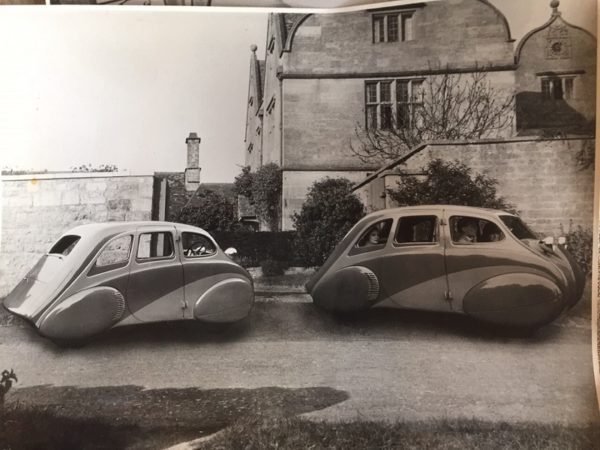
Thank you, Scott Barrett of The Automobile, for identifying this mystery car for us. Scott’s comment is shown below, but we repeat it here:
“Anders has made a good stab with his Duncan guess. This is the 1937 prototype designed by Frank Hamblin known as the FWC (ForWard Control). It was built on a Morris Minor chassis and was supposed to be fitted with a rear-mounted flat-four engine, but this was never completed and the car was little more than a static prototype. Hamblin went on to work with Roy Fedden on the Fedden car project, and after the collapse of Fedden joined Ian Duncan and Frank Lambourne to work on Duncan’s Dragonfly. He styled other vehicles although I don’t think any were built.”
The two pictures we show here (one in the headline and one below) were sent to us by Nick Hull, Associate Professor at the Coventry School of Art & Design. They are from the archive of Malcolm Sayer (21 May 1916 – 22 April 1970). It is not surprising that this aerodynamic machine was found there: Sayer was an aircraft engineer during wartime and later an automotive aerodynamicist, working for jaguar between 1951 and his death in 1970. He was responsible for much work on Jaguar designs, including the C-Type, D-Type, E-Type and XJ13. He was one of the first engineers to apply mathematical aircraft design principles of aerodynamics to cars.
Now to the pictures. They clearly piqued Malcolm Sayer’s interest, but they have no notes on the back, so Nick Hull asked whether we could post them here to see if anybody can cast more light on the identity of the car. Scott has now done that.
Nick points out that there are two examples of this prototype, which is notable for being very aerodynamic (in a period way). It is obviously rear-engined, although the interior shot reveals it is clearly a mock-up, made of wood, with no door seals, fairly crudely glued roof trim etc. On close inspection it is a 4-door: the front door extends right through the flowing front wing to the nose. Nick’s guess is that it is from the late 1940s, but it could be earlier. The location looks very British, but which British manufacturer would be investigating such a radical style and layout at that time?
Anders Clausager suspects it might be the work of a small company or even an individual, similar to the Fedden or the Kendall. But if it was, then how did Sayer come across the photos?








Anders has made a good stab with his Duncan guess. This is the 1937 prototype designed by Frank Hamblin known as the FWC (ForWard Control). It was built on a Morris Minor chassis and was supposed to be fitted with a rear-mounted flat-four engine, but this was never completed and the car was little more than a static prototype. Hamblin went on to work with Roy Fedden on the Fedden car project, and after the collapse of Fedden joined Ian Duncan and Frank Lambourne to work on Duncan’s Dragonfly. He styled other vehicles although I don’t think any were built.
Thanks Scott, very helpful information. Nick Hull